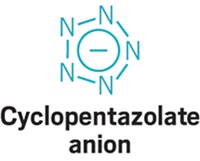Advertisement
Grab your lab coat. Let's get started
Welcome!
Welcome!
Create an account below to get 6 C&EN articles per month, receive newsletters and more - all free.
It seems this is your first time logging in online. Please enter the following information to continue.
As an ACS member you automatically get access to this site. All we need is few more details to create your reading experience.
Not you? Sign in with a different account.
Not you? Sign in with a different account.
ERROR 1
ERROR 1
ERROR 2
ERROR 2
ERROR 2
ERROR 2
ERROR 2
Password and Confirm password must match.
If you have an ACS member number, please enter it here so we can link this account to your membership. (optional)
ERROR 2
ACS values your privacy. By submitting your information, you are gaining access to C&EN and subscribing to our weekly newsletter. We use the information you provide to make your reading experience better, and we will never sell your data to third party members.
Materials
A Liquid Future For Hydrogen Fuel?
Alternative Energy: A liquid cyclic amine borane stores and releases hydrogen gas
by Louisa Dalton
November 16, 2011

To roll out a fleet of hydrogen-fueled vehicles, scientists and engineers will need to develop a practical way to store the gas. Until now, solid storage materials have dominated the hunt. Now researchers report a liquid contender: a cyclic amine borane that frees hydrogen gas while remaining liquid (J. Am. Chem. Soc., DOI: 10.1021/ja208834v).

The Department of Energy wants to develop a viable liquid or solid carrier for hydrogen fuel by 2017. Many experts would prefer a liquid, says Shih-Yuan Liu, an organic chemist at the University of Oregon, because it could slip into the current gasoline infrastructure more easily than a solid could.
Liu and his group thought they could develop such a liquid material based on their previous work. Recently, they developed a series of solid six-membered cyclic amine boranes that readily release hydrogen when they react to form trimers (J. Am. Chem. Soc., DOI: 10.1021/ja206497x). By shrinking the ring to five atoms and tweaking the structures further, the chemists stumbled upon BN-methylcyclopentane, a liquid stable in air and water. When three BN-methylcyclopentane molecules react to form a trimer, they release six molecules of hydrogen. This reaction needs only a cheap catalyst, iron chloride, and slight heating to 80 °C.
Because the trimer is also a liquid, all forms of the storage material are compatible with the gasoline infrastructure. Also, for a small compound, BN-methylcyclopentane has a surprisingly low vapor pressure, Liu says, making it unlikely to contaminate the hydrogen fuel stream.
The researchers can regenerate the starting material from the trimer with 92% yield by first reacting it with methanol and then with lithium aluminum hydride. But Liu cautions that this two-step regeneration isn’t energy efficient.
Arvind Varma, a chemical engineer at Purdue University, says the new material is “a good start,” but isn’t yet “attractive for vehicle applications.” For example, he says that the researchers need to at least double the amount of hydrogen released by a given volume of the liquid.
Liu has some ideas to improve the hydrogen yield, such as dissolving ammonia borane, a solid hydrogen storage material, in the BN-methylcyclopentane liquid.





Join the conversation
Contact the reporter
Submit a Letter to the Editor for publication
Engage with us on Twitter